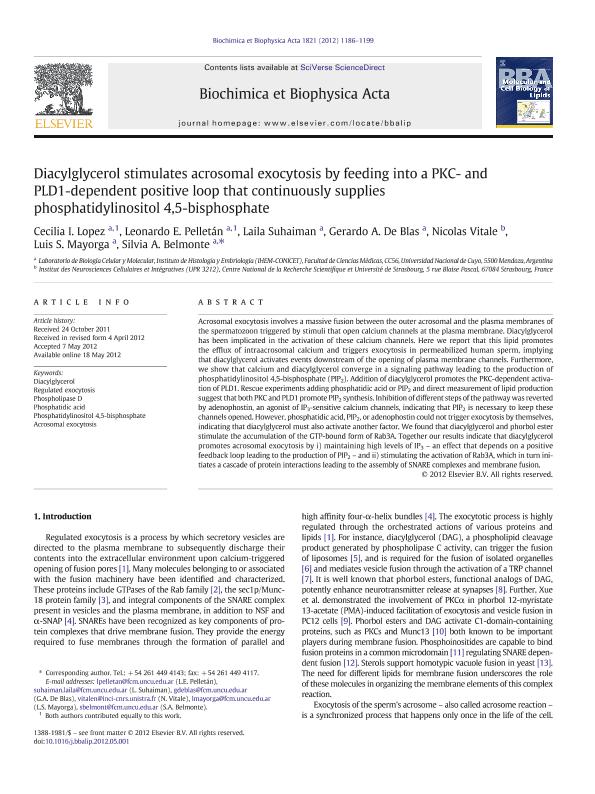Artículo
Diacylglycerol stimulates acrosomal exocytosis by feeding into a PKC- and PLD1-dependent positive loop that continuously supplies phosphatidylinositol 4,5-bisphosphate
Lopez, Cecilia Ines ; Pelletán, Leonardo Enuar
; Pelletán, Leonardo Enuar ; Suhaiman, Laila
; Suhaiman, Laila ; de Blas, Gerardo Andrés
; de Blas, Gerardo Andrés ; Vitale, Nicolas; Mayorga, Luis Segundo
; Vitale, Nicolas; Mayorga, Luis Segundo ; Belmonte, Silvia Alejandra
; Belmonte, Silvia Alejandra
 ; Pelletán, Leonardo Enuar
; Pelletán, Leonardo Enuar ; Suhaiman, Laila
; Suhaiman, Laila ; de Blas, Gerardo Andrés
; de Blas, Gerardo Andrés ; Vitale, Nicolas; Mayorga, Luis Segundo
; Vitale, Nicolas; Mayorga, Luis Segundo ; Belmonte, Silvia Alejandra
; Belmonte, Silvia Alejandra
Fecha de publicación:
09/2012
Editorial:
Elsevier Science
Revista:
Biochimica Et Biophysica Acta - Molecular and Cell Biology of Lipids
ISSN:
1388-1981
Idioma:
Inglés
Tipo de recurso:
Artículo publicado
Clasificación temática:
Resumen
Acrosomal exocytosis involves a massive fusion between the outer acrosomal and the plasma membranes of the spermatozoon triggered by stimuli that open calcium channels at the plasma membrane. Diacylglycerol has been implicated in the activation of these calcium channels. Here we report that this lipid promotes the efflux of intraacrosomal calcium and triggers exocytosis in permeabilized human sperm, implying that diacylglycerol activates events downstream of the opening of plasma membrane channels. Furthermore, we show that calcium and diacylglycerol converge in a signaling pathway leading to the production of phosphatidylinositol 4,5-bisphosphate (PIP2). Addition of diacylglycerol promotes the PKC-dependent activation of PLD1. Rescue experiments adding phosphatidic acid or PIP2 and direct measurement of lipid production suggest that both PKC and PLD1 promote PIP2 synthesis. Inhibition of different steps of the pathway was reverted by adenophostin, an agonist of IP3-sensitive calcium channels, indicating that PIP2 is necessary to keep these channels opened. However, phosphatidic acid, PIP2, or adenophostin could not trigger exocytosis by themselves, indicating that diacylglycerol must also activate another factor. We found that diacylglycerol and phorbol ester stimulate the accumulation of the GTP-bound form of Rab3A. Together our results indicate that diacylglycerol promotes acrosomal exocytosis by i) maintaining high levels of IP3 – an effect that depends on a positive feedback loop leading to the production of PIP2 – and ii) stimulating the activation of Rab3A, which in turn initiates a cascade of protein interactions leading to the assembly of SNARE complexes and membrane fusion.
Archivos asociados
Licencia
Identificadores
Colecciones
Articulos(IHEM)
Articulos de INST. HISTOLOGIA Y EMBRIOLOGIA DE MEND DR.M.BURGOS
Articulos de INST. HISTOLOGIA Y EMBRIOLOGIA DE MEND DR.M.BURGOS
Citación
Lopez, Cecilia Ines; Pelletán, Leonardo Enuar; Suhaiman, Laila; de Blas, Gerardo Andrés; Vitale, Nicolas; et al.; Diacylglycerol stimulates acrosomal exocytosis by feeding into a PKC- and PLD1-dependent positive loop that continuously supplies phosphatidylinositol 4,5-bisphosphate; Elsevier Science; Biochimica Et Biophysica Acta - Molecular and Cell Biology of Lipids; 1821; 9; 9-2012; 1186-1199
Compartir
Altmétricas



